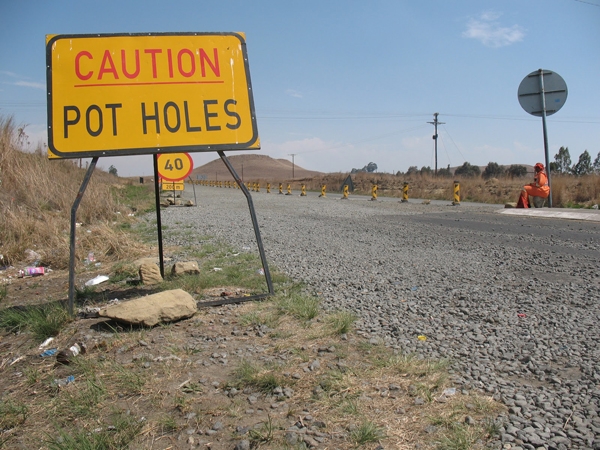Why do potholes occur?
Poor road construction, inadequate drainage and insufficient maintenance are the main causes

Across the country, potholes are an all too familiar and frustrating feature of South Africa’s roads. Archive photo: Barbara Maregele
Across the country, potholes are an all too familiar and frustrating feature of South Africa’s roads. Repairs by municipalities and road authorities are often sparse and delayed. Potholes frequently reappear within months of being patched, in a seemingly never-ending cycle of repair and reformation. But why do potholes occur?
Pothole formation
Roads are made up of several layers, each with a specific function. First, the road surface soil is prepared and compressed. Next, a base layer composed of gravel is topped with a cement-stabilised gravel layer for added strength. Above this is a layer of crushed stone, followed by the final surface layer – an asphalt mix. Asphalt is a composite material made from aggregates (crushed rock) bound together by bitumen – a thick, sticky fluid derived from petroleum.
The quality of these materials, and the way they are applied, is critical for road durability.
The other crucial factor in road construction is drainage. Water is a road’s greatest enemy, and if proper drainage is not built into the design, water will infiltrate the layers beneath the surface. Unfortunately, in South Africa, road construction often neglects drainage systems, or the drainage becomes blocked and ineffective over time, accelerating road degradation.
The asphalt mix used for many roads in South Africa is often substandard, resulting in early cracks on the road surface. These cracks allow water to seep into the layers beneath the asphalt, weakening both the road and the soil foundation.
Inadequate drainage systems further compound the problem, causing water to pool underneath the road surface. Over time, as traffic moves over these weakened areas, the material erodes and collapses, forming potholes.
Compounding this is a lack of timely road maintenance and monitoring. Once cracks begin to form, they should be addressed quickly to prevent potholes, but maintenance does not happen frequently enough to stop the issue at its source.
Tarred roads generally require resurfacing to maintain their integrity after ten years. Unfortunately, this is often delayed, leading to more frequent and severe potholes.
Alternatives
Given the ongoing challenges with asphalt roads, alternative materials are being considered. One option is concrete, which is more durable and requires less maintenance than asphalt, making it an attractive option for roads, particularly in rural areas. However, concrete is more expensive to pour and produces more road noise. Despite these drawbacks, its longer lifespan could offset the initial costs and maintenance needs, making it a potential solution for South Africa’s rural roads.
Another alternative currently under investigation by the Council for Scientific and Industrial Research is using recycled tyres as a road surface material. This innovative approach could offer both environmental and durability benefits, but the long-term reliability of these tyre-based roads is still being studied.
South Africa’s problem with potholes is a multifaceted issue that includes poor road construction practices, inferior materials, inadequate drainage and insufficient maintenance. While asphalt roads will likely remain the standard in the short term, alternatives such as concrete and recycled tyre surfaces could provide more durable solutions in the future. To ensure safer and longer-lasting roads, South Africa must explore these options and improve its maintenance strategies to prevent our roads from falling through the cracks.
Support independent journalism
Donate using Payfast

Don't miss out on the latest news
We respect your privacy, and promise we won't spam you.
Next: Durban residents without water for eight years picket at city hall
Previous: Many Cape Town stations are closed to wheelchair users
Letters
Dear Editor
Solomon Mahlangu Dr in Durban was constructed in concrete. Over the years the concrete crumbled and dangerous steep sided potholes (with rusty steel rebar in them) continued to form. Large sections were repaired but just broke up again. Eventually the city council gave up and had large sections replaced with tar.
Many heavy trucks from the harbour use this road and the concrete is not suitable for the task.
© 2024 GroundUp. This article is licensed under a Creative Commons Attribution-NoDerivatives 4.0 International License.
You may republish this article, so long as you credit the authors and GroundUp, and do not change the text. Please include a link back to the original article.
We put an invisible pixel in the article so that we can count traffic to republishers. All analytics tools are solely on our servers. We do not give our logs to any third party. Logs are deleted after two weeks. We do not use any IP address identifying information except to count regional traffic. We are solely interested in counting hits, not tracking users. If you republish, please do not delete the invisible pixel.
